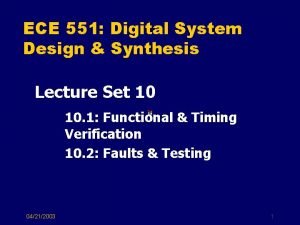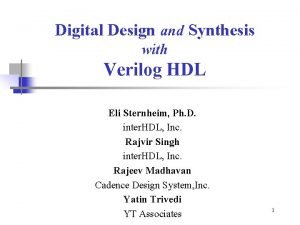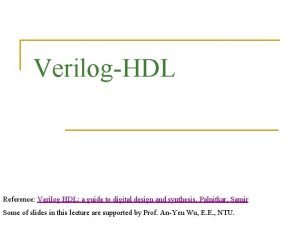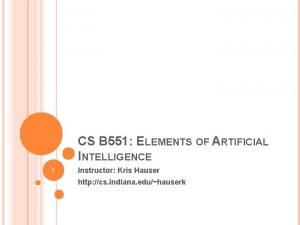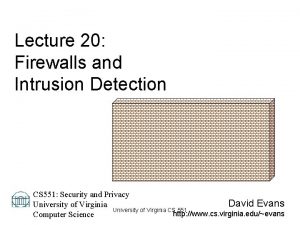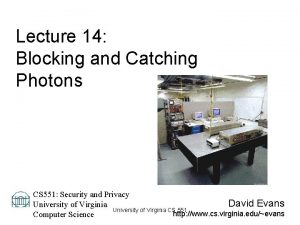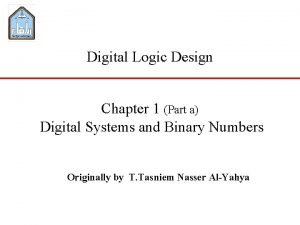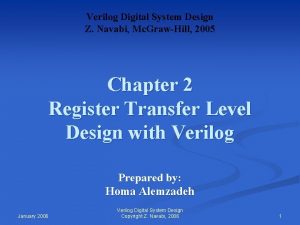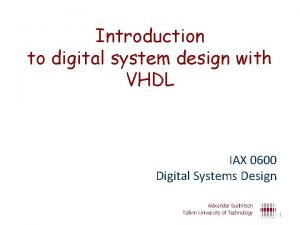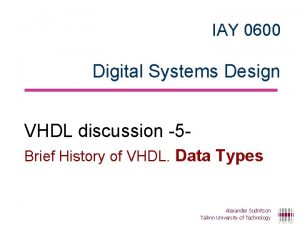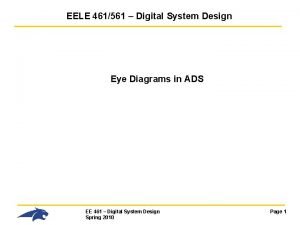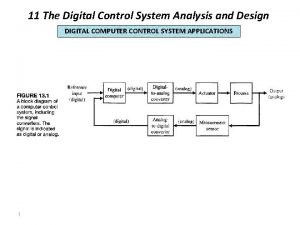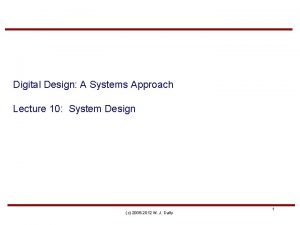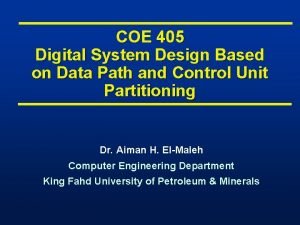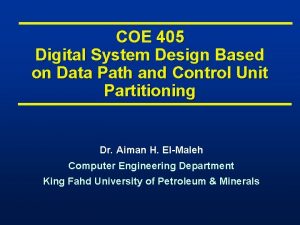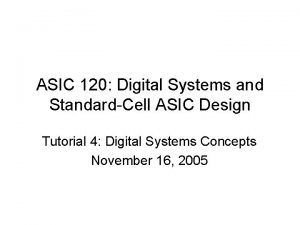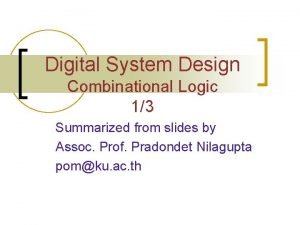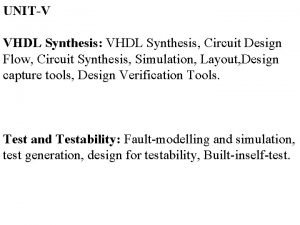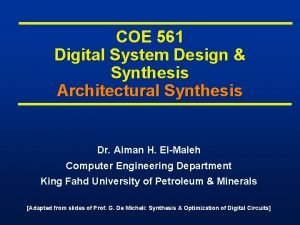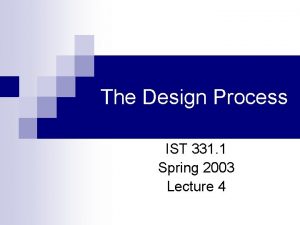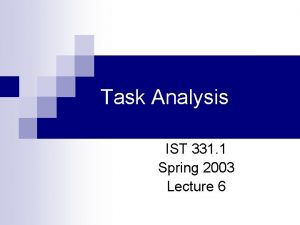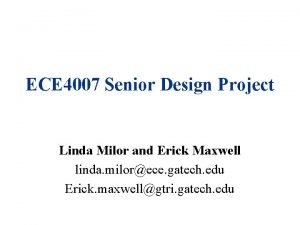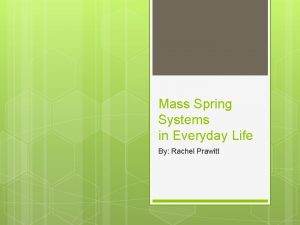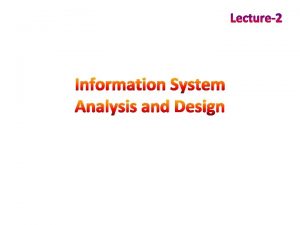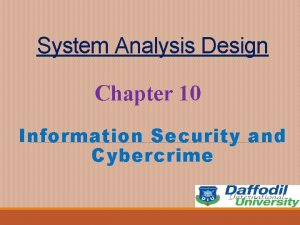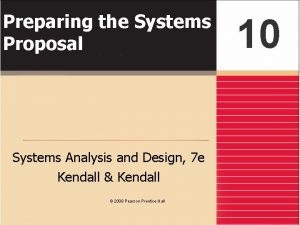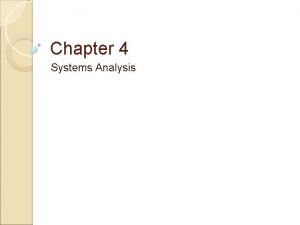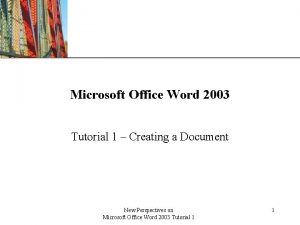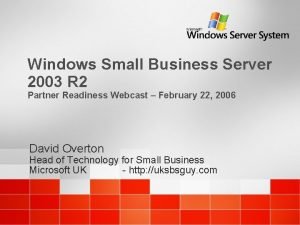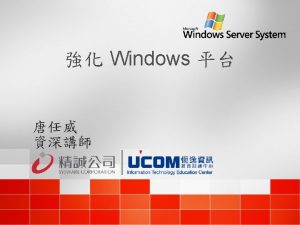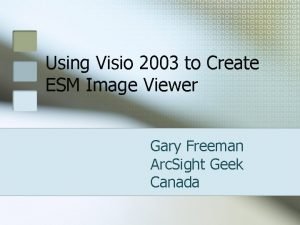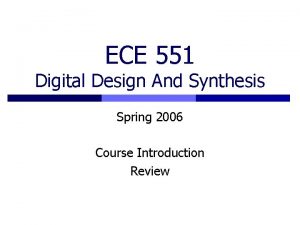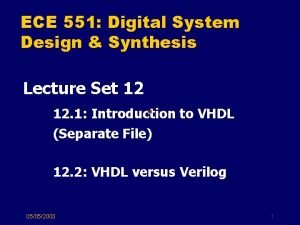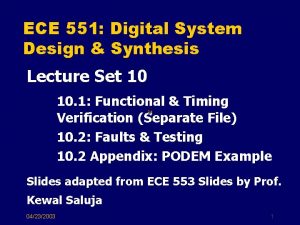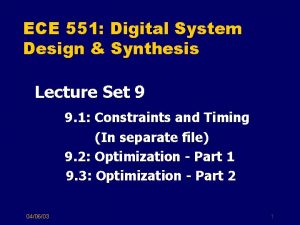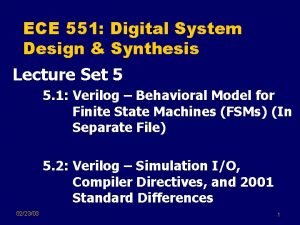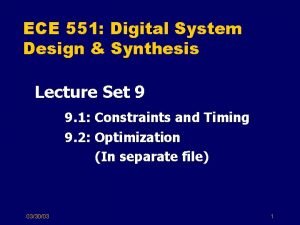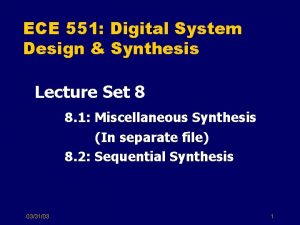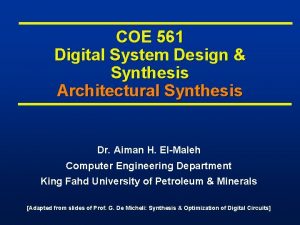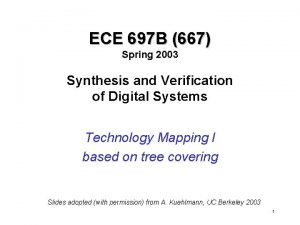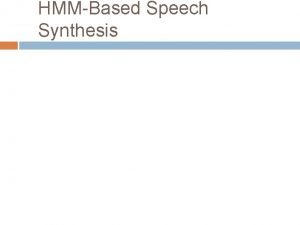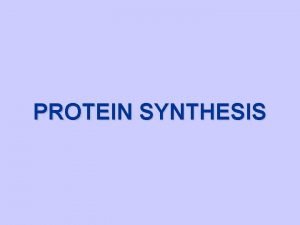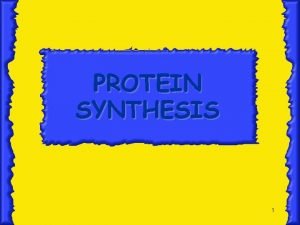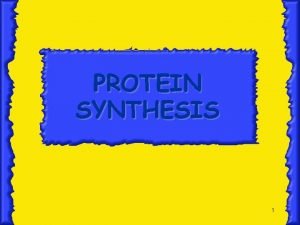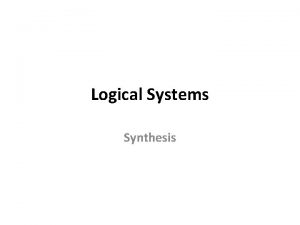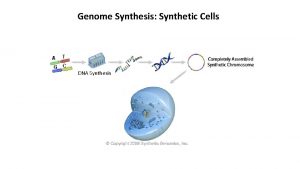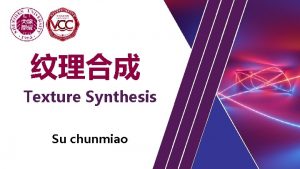ECE 551 Digital System Design Synthesis Spring 2003


















![IC Costs - 1 q An example: 10, 000 gate circuit [1] o Fixed IC Costs - 1 q An example: 10, 000 gate circuit [1] o Fixed](https://slidetodoc.com/presentation_image_h/d83ac13b4f1aff800cc9d8e2828d5a85/image-19.jpg)



































![References [1] Chris J. Myers, Asynchronous Circuit Design, John Wiley & Sons, Inc. , References [1] Chris J. Myers, Asynchronous Circuit Design, John Wiley & Sons, Inc. ,](https://slidetodoc.com/presentation_image_h/d83ac13b4f1aff800cc9d8e2828d5a85/image-55.jpg)
- Slides: 55

ECE 551: Digital System Design & Synthesis Spring 2003 Lecture Materials Prepared by: Charles Kime, Kewal Saluja and Michael Schulte 1

ECE 551: Digital System Design & Synthesis q. Lecture Set 1: o Introduction o Overview of Contemporary Digital Design o Pragmatics 1 1/16/2003 ECE 551 Spring 2003 2

ECE 551 - Digital System Design & Synthesis Lecture 1. 1 - Introduction q Overview o Course 1/16/2003 Purpose Topics Tools Info ECE 551 Spring 2003 3

Course Purpose q To provide knowledge and experience in performing contemporary logic design based on o Hardware description languages (HDLs) o HDL simulation o Automated logic synthesis o Timing analysis q With consideration for o Practical design and test issues o Chip layout issues o Design reuse for system-on-a-chip (So. C) 1/16/2003 ECE 551 Spring 2003 4

Course Topics Pragmatics of Digital Design q Hardware Modeling with the Verilog HDL q Event-Driven Simulation and Testbenches q Verilog Language Constructs and Delay q Behavioral Descriptions in Verilog q An Overview of VHDL q Logic Synthesis and Timing q Physical Design and Design Reuse q 1/16/2003 ECE 551 Spring 2003 5

Course Tools q Modelsim HDL Simulation Tools (Mentor) q Design Analyzer Synthesis Tools (Synopsys) q G 11 Technology Library (LSI Logic) 1/16/2003 ECE 551 Spring 2003 6

Course Information q Course Conduct q Standard Reference q The above plus all other course material can be found at http: //courses. engr. wisc. edu/ecow/g et/ece/551/kime/ q Be familiar with all! 1/16/2003 ECE 551 Spring 2003 7

Lecture 1. 2 – Contemporary Digital Design q Overview o Layout Lite o Application Specific Integrated Circuit (ASIC) Technologies o IC Costs o ASIC Design Flows § The Role of HDLs and Synthesis § The Role of IP Cores and Reuse § The Role of Physical Design o Summary 1/16/2003 ECE 551 Spring 2003 8

Layout Lite - 1 q IC are produced from masks that correspond to geometric layouts produced by the designer or by EDA tools. q In CMOS, a typical IC cross-section: Metal 3 Oxide Metal 2 Metal 1 Transistor Substrate 1/16/2003 Polysilicon Diffusion Channel ECE 551 Spring 2003 9

Layout Lite - 2 q The layout corresponding to the cross-section: Transistor Channel o The transistor is outlined in broad yellow lines. o Everything else is interconnect. 1/16/2003 ECE 551 Spring 2003 10

IC Implementation Technologies STANDARD IC ASIC FULL CUSTOM STANDARD CELL 1/16/2003 SEMICUSTOM GATE ARRAY, SEA OF GATES FIELD PROGRAMMABLE FPGA ECE 551 Spring 2003 PLD 11

Distinguishing Features of IC Technologies - 1 q Implementation technologies are distinguished by: o The levels of the layout 1) transistors and 2) interconnect that are: § Common to distinct IC designs (L 1) § Different for distinct IC designs (L 2) o The use of predesigned layout cells § Predesigned cells are used (P 1) § Predesigned cells are not used (P 2) 1/16/2003 ECE 551 Spring 2003 12

Distinguishing Features of IC Technologies - 2 q Implementation technologies are distinguished by: o Mechanism used for instantiating distinct IC designs: § Metallization (M) § Fuses or Antifuses (F) § Stored Charge (C) § Static Storage (R) 1/16/2003 ECE 551 Spring 2003 13

Technologies in Terms of Distinguishing Features - 1 q Full Custom – P 2, M o Transistors – L 2, Interconnects – L 2 q Standard Cell – P 1, M o Transistors – L 2, Interconnects – L 2 q Gate Array, Sea of Gates – P 1, M o Transistors – L 1, Interconnects – L 2 1/16/2003 ECE 551 Spring 2003 14

Technologies in Terms of Distinguishing Features - 2 q FPGA – P 1, F or R o Transistors – L 1, Interconnects – L 1 q PLD – P 1, F or C o Transistors – L 1, Interconnects – L 1 1/16/2003 ECE 551 Spring 2003 15

Technologies in Terms of Shared Fabrication Steps q Custom Fabricated Layers o Full Custom and Standard Cells – all layers are custom fabricated o Gate Arrays and Sea of Gates – only interconnect (metallization) layers custom fabricated o FPGAs and PLDs – nothing is custom fabricated q Consequences due to economy-of-scale: o Fab costs reduced for Gate Arrays and Sea of Gates o Fab costs further reduced for FPGAs and PLDs 1/16/2003 ECE 551 Spring 2003 16

Layout Styles - 1 q Technologies in terms of layout styles: Standard Cell Adjustable Spacing … Megacells Gate Array - Channeled Fixed Spacing … Base Cell 1/16/2003 ECE 551 Spring 2003 17

Layout Styles - 2 q Technologies in terms of layout styles: Gate Array - Channel-less … (Sea of Gates) Base Cell Gate Array - Structured Fixed Embedded Block 1/16/2003 ECE 551 Spring 2003 … … 18
![IC Costs 1 q An example 10 000 gate circuit 1 o Fixed IC Costs - 1 q An example: 10, 000 gate circuit [1] o Fixed](https://slidetodoc.com/presentation_image_h/d83ac13b4f1aff800cc9d8e2828d5a85/image-19.jpg)
IC Costs - 1 q An example: 10, 000 gate circuit [1] o Fixed costs § Standard Cell - $146, 000 § Gate Array - $86, 000 § FPGA - $21, 800 o Variable costs § Standard Cell - $8 per IC § Gate Array - $10 per IC § FPGA - $39 per IC 1/16/2003 ECE 551 Spring 2003 19

IC Costs - 2 q An 1/16/2003 example: 10, 000 gate circuit ECE 551 Spring 2003 20

IC Costs – 3 q Why isn’t FPGA cheaper unit due to economy-of-scale? o The chip area required by each of the successive technologies from Full Custom to FPGAs increases for a fixed-sized design. o The larger the chip area, the poorer the yield of working chips during fabrication o Also, due to increased sales, FPGA prices have declined since the mid-90’s much faster than the other technologies. 1/16/2003 ECE 551 Spring 2003 21

ASIC Design Flow - Traditional Write Specifications Draw Datapath Schematics * Define System Architecture Define State Diag/Tables Partition - Datapath &Control Draw Control Schematics * Do Physical Design* *Steps followed by validation Implement* 1/16/2003 and refinement ECE 551 Spring 2003 Integrate Design* 22

Traditional Flow Problems q Schematic Diagrams o Limited descriptive power o Limited portability o Limited complexity q State Diagrams and Algorithmic State Machines o Limited complexity o Difficult to describe parallelism q Time-Intensive and Hard to Update 1/16/2003 ECE 551 Spring 2003 23

How about HDLs Instead of Diagrams? - 1 q Hardware description languages (HDLs) o Computer-based programming languages o Model and simulate the functional behavior and timing of digital hardware o Synthesizable into a technology-specific netlist q Two main HDLs used by industry o Verilog HDL (C-based, industry-driven) o VHSIC HDL or VHDL (Ada-based, defense/industry/university-driven). 1/16/2003 ECE 551 Spring 2003 24

How about HDLs Instead of Diagrams? - 2 q Advantages of HDLs o Highly portable (text) o Describes multiple levels of abstraction o Represents parallelism o Provides many descriptive styles § Structural § Register Transfer Level (RTL) § Behavioral o Serve as input ECE for 551 synthesis Spring 2003 1/16/2003 25

How about Synthesis instead of Manual Design? q Increased q Potential q Ability space 1/16/2003 for better optimization to explore more of overall design q Reduces q Are design efficiency verification/validation problem there disadvantages? ECE 551 Spring 2003 26

HDL/Synthesis Design Flow - 1 Design Specification Design Partition Design Entry: HDL Behavioral 1/16/2003 Verification: Functional Pre-Synthesis Sign-Off Integration Synthesis and Technology Map Verification: Functional ECE 551 Spring 2003 To next page 27

HDL/Synthesis Design Flow - 2 From prior page Verification: Post-Synthesis Timing Verification: Post-Synthesis 1/16/2003 Test Generation & Fault Simulation Extract Parasitics Physical Design Verification: Physical & Electrical ECE 551 Spring 2003 Design Sign-Off 28

An Example from Industry q A G 3 wireless processor was designed using the following methodology: o Entire processor modeled and tested using VHDL and C-based test programs o Processor functionality verified by synthesizing to an FPGA and running 3 G wireless applications at 25 MHz o Processor timing and design feasibility verified by synthesizing to a standard cell library and running applications at 500 MHz. o Final version of processor implemented using a mix of standard cell and custom logic to achieve low-power and 800 MHz clock speed. 1/16/2003 ECE 551 Spring 2003 29

Newer Technologies and Design Flows - SOC System-on-a-Chip (So. C) o Designers use (Intellectual Property – IP) cores q RISC Core, DSP, Microcontroller, Memory q The main function is to glue many cores and generate/design only those components for which cores and designs may not be available q Used in ASIC as well as custom design environment q The issues relevant to this will be discussed near the end of the course 1/16/2003 30 ECE 551 Spring 2003 q

Contemporary Design Flow - 1 Design Specification Design Partition Select IP Cores 1/16/2003 Preliminary Phys. Design Entry: HDL Behavioral Verification: Functional Integration & Verification: Functional Pre-Synthesis Sign-Off Synthesis and Technology Map To HDL/Synth Design Flow -2 ECE 551 Spring 2003 31

Lecture 1. 2 Summary q Application Specific Integrated Circuit (ASIC) Technologies o Provides a basis for what we will design q IC Costs o Gives a basis for technology selection q ASIC Design Flows o Shows the role of HDLs and synthesis o Provides a structure for § what we will learn § What we will do 1/16/2003 ECE 551 Spring 2003 32

References 1) Smith, Michael J. S. , Application. Specific Integrated Circuits, Addison. Wesley, 1997. 1/16/2003 ECE 551 Spring 2003 33

Lecture 1. 3 Pragmatics 1 q Pragmatics refers to practical design choices and techniques q Topics o Cell Libraries o Asynchronous Circuits o Three-State Logic and Hi-Z State 1/16/2003 ECE 551 Spring 2003 34

Cells and Cell Libraries q What is a cell? q What is a cell library? q What appears in the cell library for each ASIC cell? 1/16/2003 ECE 551 Spring 2003 35

What is a Cell? Cells are the building blocks for digital designs q Come in different sizes, shapes and functions varying from transistors to large memory arrays or even a processor q Typically cells: q o Small Scale: AND, OR, NAND, NOR, NOT, AOI, OAI, Flip-Flops, Latches o Medium Scale: Multiplexers, Decoders, Adders o Large Scale: Memories, Processors q Provided by ASIC vendors 1/16/2003 ECE 551 Spring 2003 36

What is a Cell Library? q. A database specifying and describing the target technology in the form of predesigned objects called cells. Synthesis target technology. q In-Class Discussion: What are typical components in the database for each cell? 1/16/2003 ECE 551 Spring 2003 37

Asynchronous Techniques q Delay-dependent design q Combinational hazards q Combinational hazard prevention q Asynchronous design 1/16/2003 ECE 551 Spring 2003 38

Delay-Dependent Design 1 LA PA A LA A PA Example: Level-to-Pulse Converter(Delay-Based) 1/16/2003 ECE 551 Spring 2003 39

Delay-Dependent Design 2 q Sometimes useful q But should be avoided q Time delays vary and so may: o Fail o Produce variable results, e. g. pulse length 1/16/2003 ECE 551 Spring 2003 40

Delay-Dependent Design 3 q Level to Pulse Converter (Synchronous) LA PA D Clock q C Q Level on LA must be longer than a clock period and must not rise close to the positive clock edge. Ideally, synchronous with Clock. 1/16/2003 ECE 551 Spring 2003 41

Combinational Hazards 1 q Example - Hazard in a Multiplexer A 1 B F 1 C B F 1/16/2003 ECE 551 Spring 2003 42

Combinational Hazards - 2 A circuit has a hazard if there exists an assignment of delays such that an unwanted signal transition (glitch), can occur. q Types of changes on combinational circuit inputs : q o Single-input change (SIC) o Multiple-input change (MIC) q A SIC static hazard exists on a circuit output if in response to a SIC, the output momentarily changes to the opposite value. o Static 1 -hazard – output value to remain at 1 o Static 0 -hazard – output value to remain at 0 1/16/2003 ECE 551 Spring 2003 43

Combinational Hazards - 3 q Classification of Combinational Hazards o Static – SIC/MIC – output changes when it should remain fixed - output value within the “transition region of input changes is fixed. o Dynamic – SIC/MIC – output changes three or more times when it should change only once. o Essential – MIC – output changes when it should remain fixed – output value within the “transition region” of input changes not fixed. 1/16/2003 ECE 551 Spring 2003 44

Combination Hazards - 4 q In-class Example: Illustration of static, dynamic and essential hazards 1/16/2003 ECE 551 Spring 2003 45

Combinational Hazards - 5 q Consequences of Hazards o Signals with hazards within or entering asynchronous circuits (note that a flip-flop is an asynchronous circuit with respect to its clock signal!) o Cause incorrect state behavior § Extra state changes § Incorrect state changes q In-Class Example: Prevention of Hazards o Redundant Logic o Delay Dependence 1/16/2003 ECE 551 Spring 2003 46

Asynchronous Design - 1 q Which of the following sequential circuits involve asynchronous design? o A circuit that has no global clock signal involved in its operation – state changes occur in response to input changes only. o A D flip-flop circuit o A circuit using clock gating on flip-flop clock inputs o A circuit with a clock which uses the clear and preset inputs on the flip-flops for other than initialization. 1/16/2003 ECE 551 Spring 2003 47

Asynchronous Design - 2 Because of the difficulty of eliminating hazards, it is very difficult to insure correct operation under all timing possibilities q Design must be done manually or by use of very specialized synthesis tools. q Therefore, avoid it if you can! q If you truly need it, investigate some of the more contemporary approaches[1] which avoid some of the many difficulties. q 1/16/2003 ECE 551 Spring 2003 48

Three-State and Other Hi-Z States Three-state conflicts q Floating three-state nets and inputs q Pull-ups and Pull-downs q Bus keepers q 1/16/2003 ECE 551 Spring 2003 49

Three-State Conflicts - 1 q What are they and what are their effects? o Static – Chip damage or static power consumption o Dynamic – Dynamic or static power consumption 1/16/2003 1 D 0 1 E 0 0 D 1 1 E 0 1 E 1 1 E 0 E 1 1 0 OUT ECE 551 Spring 2003 50

Three-State Conflicts - 2 q How can conflicts be avoided? o Static – Decoded enable signals o Dynamic – Delay control 1 0 1/16/2003 E 0 E 1 1 0 D 0 E 0 1 E 0 0 E 1 1 OUT D 1 ECE 551 Spring 2003 51

Floating Inputs and Three. State Nets - 1 q Floating input values on gates can cause: o static power dissipation o high-frequency switching that induces power supply noise q Floating input values arise from: o Gate inputs, e. g. , for example on exterior of IC, that are not connected o Lines driven by 3 -state buffer or gate outputs, all of which are in the Hi-Z state. 1/16/2003 ECE 551 Spring 2003 52

Floating Inputs and Three. State Nets – 2 q How can floating inputs and nets be avoided? o Use a pull-up or pull-down resistor or transistor with a fixed gate voltage value. § Advantage – simple § Disadvantages – static power dissipation and loading of node o On internal lines, particularly buses, use a bus keeper (weak buffer) 1/16/2003 ECE 551 Spring 2003 53

Non-D flip-flops q D Flip-Flops o Unique characteristic – the typical master-slave DFF is also functionally an edge-triggered DFF. q Non- D Flip-Flops (JK, T, etc. ) o In the cell libraries, these flip-flop may be full-custom designs or may simply consist of a DFF with added logic. o If it is just a DFF with added logic, you might as well design for a DFF to give the logic optimization software more flexibility. 1/16/2003 ECE 551 Spring 2003 54
![References 1 Chris J Myers Asynchronous Circuit Design John Wiley Sons Inc References [1] Chris J. Myers, Asynchronous Circuit Design, John Wiley & Sons, Inc. ,](https://slidetodoc.com/presentation_image_h/d83ac13b4f1aff800cc9d8e2828d5a85/image-55.jpg)
References [1] Chris J. Myers, Asynchronous Circuit Design, John Wiley & Sons, Inc. , New York, 2001. 1/16/2003 ECE 551 Spring 2003 55
 Giduk
Giduk Ece 551
Ece 551 Ece 551
Ece 551 Verilog hdl: a guide to digital design and synthesis pdf
Verilog hdl: a guide to digital design and synthesis pdf Verilog hdl: a guide to digital design and synthesis
Verilog hdl: a guide to digital design and synthesis Months for spring
Months for spring 18 446 744 073 709 551 615
18 446 744 073 709 551 615 Há um rio cristalino onde os santos viverão
Há um rio cristalino onde os santos viverão 649 hangi yüzlüğe yuvarlanır
649 hangi yüzlüğe yuvarlanır Akpc 551
Akpc 551 I 551 number
I 551 number Csci-b 551 elements of artificial intelligence
Csci-b 551 elements of artificial intelligence Cs 551
Cs 551 Number 551
Number 551 Cs 551
Cs 551 Digital logic design number system
Digital logic design number system Digital systems design using verilog
Digital systems design using verilog Vhdl design flow
Vhdl design flow Vhdl
Vhdl Ads eye diagram
Ads eye diagram Control system analysis
Control system analysis Digital design: a systems approach
Digital design: a systems approach Asmd chart for digital system design
Asmd chart for digital system design Difference between asm and asmd chart
Difference between asm and asmd chart Standardcels
Standardcels Digital system design
Digital system design Vhdl synthesis circuit design flow
Vhdl synthesis circuit design flow Design synthesis architecture
Design synthesis architecture Ist 331
Ist 331 Analysisist
Analysisist Linda milor
Linda milor Mass spring system in real life
Mass spring system in real life Warga digital
Warga digital Digital market and digital goods
Digital market and digital goods Digital data digital signals
Digital data digital signals Data encoding and transmission
Data encoding and transmission E-commerce: digital markets, digital goods
E-commerce: digital markets, digital goods Data encoding techniques
Data encoding techniques Rdi board
Rdi board Unique features of digital markets
Unique features of digital markets Basic principles of input design
Basic principles of input design User interface design in system analysis and design
User interface design in system analysis and design Dialogue design in system analysis and design
Dialogue design in system analysis and design Characteristics of system analysis
Characteristics of system analysis System security in system analysis and design
System security in system analysis and design System proposal in system analysis and design
System proposal in system analysis and design Well design feasibility
Well design feasibility Definition of system analysis
Definition of system analysis Tutorial word 2003
Tutorial word 2003 Montreux record meaning
Montreux record meaning Windows small business server 2003
Windows small business server 2003 Windows 2003 service pack 1
Windows 2003 service pack 1 Where did wilson rawls live
Where did wilson rawls live 2003 ub
2003 ub Visio 2003 viewer
Visio 2003 viewer Microsoft server
Microsoft server

